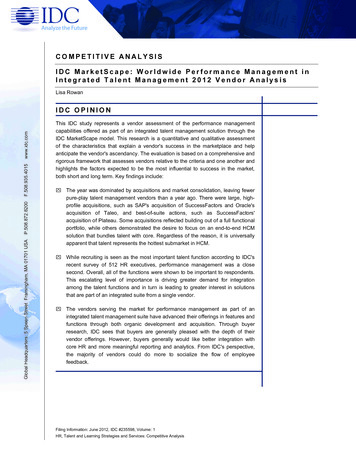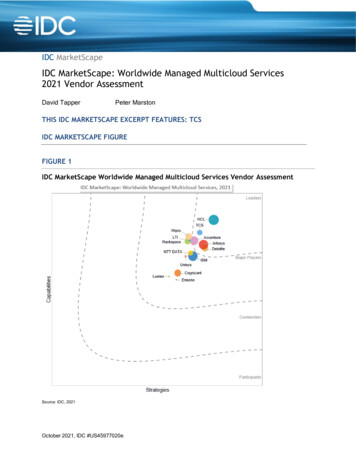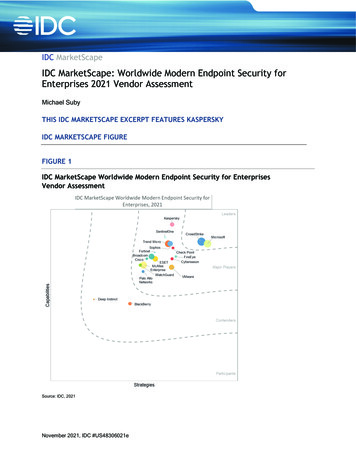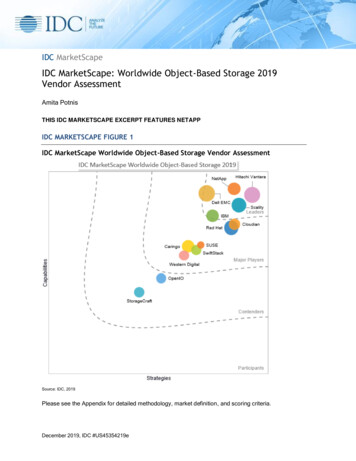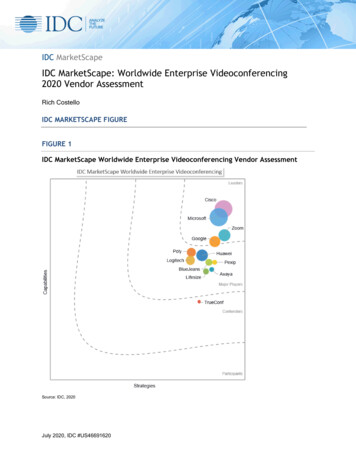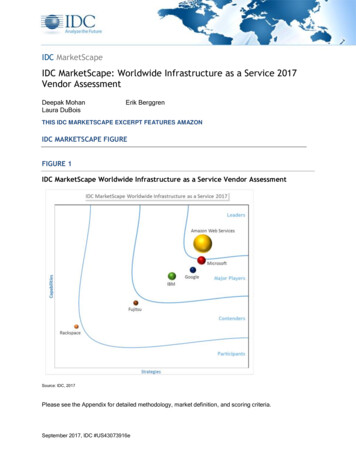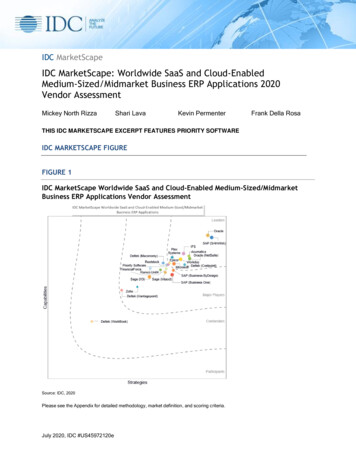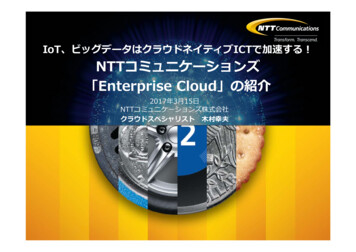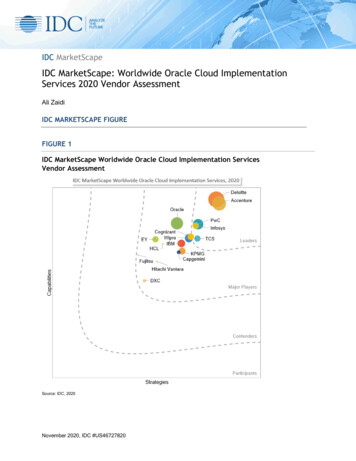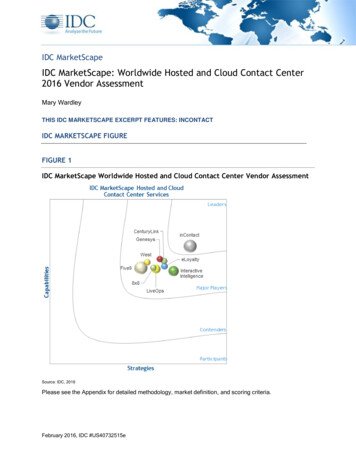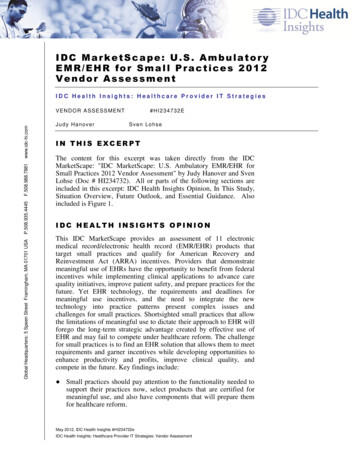
Transcription
IDC MarketScape: U.S. AmbulatoryEMR/EHR for Small Practices 2012Vendor AssessmentIDC Health Insights: Healthcare Provider IT StrategiesGlobal Headquarters: 5 Speen Street Framingham, MA 01701 USAP.508.935.4445F.508.988.7881www.idc-hi.comV E N D O R A S S E S S ME N TJ u d y H a n o ve r#HI234732ES ve n L o h s eIN THIS EXCERPTThe content for this excerpt was taken directly from the IDCMarketScape: "IDC MarketScape: U.S. Ambulatory EMR/EHR forSmall Practices 2012 Vendor Assessment" by Judy Hanover and SvenLohse (Doc # HI234732). All or parts of the following sections areincluded in this excerpt: IDC Health Insights Opinion, In This Study,Situation Overview, Future Outlook, and Essential Guidance. Alsoincluded is Figure 1.IDC HEALTH INSIGHTS OPINIONThis IDC MarketScape provides an assessment of 11 electronicmedical record/electronic health record (EMR/EHR) products thattarget small practices and qualify for American Recovery andReinvestment Act (ARRA) incentives. Providers that demonstratemeaningful use of EHRs have the opportunity to benefit from federalincentives while implementing clinical applications to advance carequality initiatives, improve patient safety, and prepare practices for thefuture. Yet EHR technology, the requirements and deadlines formeaningful use incentives, and the need to integrate the newtechnology into practice patterns present complex issues andchallenges for small practices. Shortsighted small practices that allowthe limitations of meaningful use to dictate their approach to EHR willforego the long-term strategic advantage created by effective use ofEHR and may fail to compete under healthcare reform. The challengefor small practices is to find an EHR solution that allows them to meetrequirements and garner incentives while developing opportunities toenhance productivity and profits, improve clinical quality, andcompete in the future. Key findings include: Small practices should pay attention to the functionality needed tosupport their practices now, select products that are certified formeaningful use, and also have components that will prepare themfor healthcare reform.May 2012, IDC Health Insights #HI234732eIDC Health Insights: Healthcare Provider IT Strategies: Vendor Assessment
Key features of products that are expected to be needed for smallpractices to compete in the healthcare reform environment includeflexible functionality that can be configured to support practiceworkflows, highly usable clinical documentation tools thatpreserve productivity, strong decision support capabilities,interoperability, and clinical, financial, and operational analytics. Additional features that small practices should consider includemobility options for the use of mobile devices, pricing, thefinancial stability of the vendor, and the licensing models offered.IN THIS STUDYThis IDC Health Insights study uses the IDC MarketScape softwarevendor assessment model to provide a quantitative and qualitativeassessment of the capabilities and strategies of EMR/EHR vendorswith solutions targeted at the small practice ambulatory EHR market.The assessment is based on buyer and vendor surveys, analysts'assessment, and observations of industry best practices.For practices implementing EHR and hospitals selecting EHR foraffiliated practices, with implementations in progress or consideringreplacing existing technology, this report presents solutions that meetcurrent regulatory requirements and help to prepare practices for thefuture demands of healthcare reform. Most U.S. practices consideringEMR/EHR have concerns about their ability to implement whilepreserving productivity, workflow, and quality of care. Many practicesthat already have EMR/EHR in place struggle with these same issues.This report presents, compares, and evaluates 11 solutions that includemarket leaders and innovators that supply technology that meetsregulatory requirements and the needs of small practices. Thesesolutions support the concerns specific to small practices, help topromote patient safety and improve the quality of care, preserverevenue streams, and prepare practices to compete in the new businessmodels emerging under healthcare reform.MethodologyIDC MarketScape criteria selection, weightings, and vendor scoresrepresent well-researched IDC judgment about the market and specificvendors. IDC analysts tailor the range of standard characteristics bywhich vendors are measured through structured discussions, surveys,and interviews with market leaders, participants, and end users. Market#HI234732e 2012 IDC Health Insights
weightings are based on user interviews, buyer surveys, and the inputof a review board of IDC experts in each market. IDC analysts baseindividual vendor scores, and ultimately vendor positions on the IDCMarketScape, on detailed surveys and interviews with the vendors,publicly available information, and end-user experiences in an effort toprovide an accurate and consistent assessment of each vendor'scharacteristics, behavior, and capability.Sources of information for this report include: Vendor briefings. Briefings were provided by the vendors thathave products featured in the report, with the exception ofMEDITECH, which was offered the opportunity to providebriefings, but declined. Customer references. Interviews were held with customers of theproducts covered in the report, including those references providedby the vendors as well as other customer references known to IDCHealth Insights. At least two detailed half-hour referenceconversations were held for each product covered. Secondary research. Secondary research for the report includedvendor, user, and product Web sites and blogs, as well as existingIDC Health Insights research covering this market and theseproducts.The definitions of EMR and EHR can be complicated and confusing.This report uses the term EMR/EHR to refer to those EMR and EHRproducts that meet, or are expected to meet, the federal qualificationsfor certification for meaningful use. More information on thedefinitions of EMR and EHR and the certification for meaningful useare provided in the Learn More section of this report.SITUATION OVERVIEWThe market for electronic health and medical records is maturingrapidly, under the influence of government incentives for theAmerican Recovery and Reinvestment Act of 2009. ARRA presents anunprecedented opportunity for providers to garner federal incentivesfor demonstrating meaningful use of clinical applications that will helpto improve the quality of care, enhance patient safety, and preparetheir practices for the future. However, the EHR technology itself, therequirements and deadlines for achieving meaningful use andcapturing incentives, and the need to change their business practicesand integrate the new technology into practice patterns presentcomplex issues and challenges.If providers allow the constraints of meaningful use to dictate theirtechnology choices and limit the goals for implementation, they willonly see the short-term incentives and not the long-term benefits that 2012 IDC Health Insights#HI234732ePage 1
EHRs can bring to their practices. How should providers go aboutselecting and implement EHRs that meet the requirements but also fittheir practices and provide opportunities to enhance productivity andprofits, improve clinical quality, and compete in the emerging healthreform landscape? This IDC MarketScape highlights the attributes andkey capabilities that providers should look for when selecting an EHR,and offers a guide for using best practice–based approaches toleveraging an EHR to build competitive advantage in small practices.FUTURE OUTLOOKIDC MarketScape Ambulatory EMR/EHR forSmall Practices Market Vendor AssessmentThe IDC MarketScape vendor assessment for ambulatory EMR/EHRproducts targeted at small practices represents IDC Health Insights'opinion on which vendors are well positioned today through currentcapabilities and which vendors are well positioned to gain marketshare over the next few years. Positioning in the upper right of the gridindicates that vendors are well positioned to meet market needs. Themost critical criteria for positioning on the x-axis and y-axis are asfollows: Positioning on the y-axis or capabilities axis reflects the vendor'scurrent capabilities and menu of services and how well aligned it isto customer needs. The capabilities category focuses on thecapabilities of the company and product today, here and now.Under this category, IDC analysts look at how well a vendor isbuilding/delivering capabilities that enable it to execute its chosenstrategy in the market. Positioning on the x-axis or strategy axis indicates how well thevendor's future strategy aligns with what customers will require inone to four years. The strategies category focuses on high-levelstrategic decisions and underlying assumptions about offerings,customer segments, business, and go-to-market plans for thefuture, in this case defined as the next one to four years. Under thiscategory, analysts look at whether or not a supplier's strategies invarious areas are aligned with customer requirements (andspending) over a defined future time period.Figure 1 shows each vendor's position in the vendor assessment chart.Its market share is indicated by the size of the bubble and a ( ), (-), or() icon indicates whether or not the vendor is growing faster than,slower than, or even with, respectively, overall market growth.Page 2#HI234732e 2012 IDC Health Insights
FIGURE 1IDC MarketScape: U.S. Ambulatory EMR/EHR for Small Practices MarketVendor AssessmentSource: IDC Health Insights, 2012Vendor Summary AnalysiseClinicalWorkseClinicalWorks (www.eclinicalworks.com) is a privately heldcompany founded in 1999 and headquartered in Westborough,Massachusetts. It reports 2011 revenue of more than 210 million.eClinicalWorks is focused entirely on the ambulatory EMR/EHR andpractice management space, and its product suite is marketed under thecompany name. eClinicalWorks is focused on providing low-cost,intuitive functionality to outpatient ambulatory practices of all sizes.The company has strong penetration among small, midsize, and large 2012 IDC Health Insights#HI234732ePage 3
practice groups and networks of practices and claims that 60,000providers in 9,000 practices use its products. The product suiteincludes an EMR/EHR and an integrated practice managementapplication.The eClinicalWorks suite of EMR/EHR and PM software is typicallydeployed together and is available on most deployment platforms andpayment models. The eClinicalWorks EMR/EHR is Internet based andcan be either installed at customer sites or accessed as SaaS, suppliedby eClinicalWorks. About 90% of sales are direct, and eClinicalWorksprovides its own implementation services using an in-house team and atemplated 12-week implementation process for EMR and PM, or 8weeks for just EMR.Specific functionality for particular practices, specialties, and usage(e.g., eClinicalMobile) can be easily enabled within the basic softwaresuite. eClinicalWorks integrates with numerous third-party hospitalsystems via XML, IHE, or HL7 data transfer. eClinicalWorks isenabled for use on wireless devices and optimized for use with tabletPCs. Reporting is ad hoc via eBO that uses Cognos 8.0 and isindividualized for the needs of the large provider groups that make upthe majority of the company's customer base. eClinicalWorksreporting is used for participation in pay-for-performance programs bya number of its clients and has met the requirements for reporting byfederally qualified health centers.eClinicalWorks has experienced rapid growth since 2004 and claims tohave grown 44% from 2009 to 2010. The range of practice sizesamong its client base spans from 1 to 1,700 providers. High-profilecustomers include Memorial Hermann, Children's Hospital Boston,Children's National, Northwestern, BayCare Health System, TuftsMedical Center, and 33% of the country's federally qualified healthcenters, as well as the New York City Department of Health andMental Hygiene. eClinicalWorks is CCHIT ONC-ATCB certified for2011–2012 with an additional certification for Child Health in 2008and for 2011–2012. eClinicalWorks is listed in the IDC MarketScape'sMajor Players quadrant and the Leaders quadrant in IDCMarketScape: U.S. Ambulatory EMR/EHR for Midsize and LargePractices 2011 Vendor Assessment (#HI230719, November 2011) andshould be considered a strong choice for practices that want a costcompetitive, innovative, highly configurable solution that can serve awide range of practices in the community in both SaaS-based and onpremise installations and offers significant opportunity for growth.Page 4#HI234732e 2012 IDC Health Insights
ESSENTIAL GUIDANCEActions to ConsiderFor Small Practices Selecting New and Replacement EHRsChoosing the right EMR/EHR solution will help to accelerate adoptionfor practices and drive users toward both meaningful use and thequality and efficiency goals of healthcare reform. An EMR/EHRsolution for a small practice should include: Functionality. The solution should offer functionality that meetsthe requirements of meaningful use now, while providingfunctionality and a product road map that will prepare smallpractices for healthcare reform. Industry standards. Interoperability is a requirement ofmeaningful use and healthcare reform, and providers will need toimplement interoperable systems that participate in healthinformation exchange and actively exchange data with localhospitals, payers, and other providers to qualify for reimbursementunder ARRA and participate in future accountable deliverynetworks. Providers should consider EMR/EHR products thatutilize industry standards and interoperability that createsefficiencies for providers and allows collaboration with fellow careproviders in the community that will be essential for smallpractices to participate in and thrive under accountable care. Pricing and value. Solutions should offer pricing that correlateswell with the value of the application to the practice in question,taking into account that one size does not fit all and the needs ofsmall practices differ from those of large. Vendors should offerlicensing options that meet the requirements of small practices.EMR/EHR application choices include decisions about architectureand delivery. SaaS options. Practices should carefully consider whether theyplan to invest in onsite servers and support, or if offsite hosting andSaaS offerings are more practical given their available resourcesfor support, facilities, and budget. Decisions on delivery andlicensing affect the implementation process, cost of the application,and the eventual experience of the practice in the day-to-day use ofthe application. The architecture of the application, and howsuitable this architecture is to delivery via hosting and/or SaaS, arestrong determinants of the functionality and performance availablefrom the application, as well as the cost, and should be consideredduring the selection process. User interface. Solutions should offer user interfaceconfigurability that can meet the needs of the practice now and in 2012 IDC Health Insights#HI234732ePage 5
the near future. Unlike many of the other applications used in theambulatory setting, such as practice management and billingapplications, EMRs/EHRs are used by the providers themselvesand not office staff. As they use the EMR/EHR to documentclinical encounters, the application will be used for long periods oftime, every day. Providers need to be intimately involved in theselection process to ensure that the style of the application fits theirneeds and, in large practices, those of their peers. Physician, nurse, and other staff buy-in. Physician, nurse, andstaff buy-in and participation in both the system selection andimplementation and the determination of configuration options arecritical for a successful EMR/EHR implementation in a smallpractice. Early participation in system selection can help identifyelectronic documentation and ordering solutions that have simpleand intuitive functionality that meets the needs of the practice.Participation can also help clinical staff to better understand tradeoffs that need to be made during the decision process. End-to-end technology assessment. The technology aspects ofEMR/EHR adoption only begin with selecting and licensing asoftware solution. While the right software functionality can easethe workflow transition and burden of adoption on providers, theIT infrastructure at the practice also needs to be prepared for theEMR/EHR or a solution such as SaaS selected that lowersinfrastructure requirements. EMR/EHR response time, uptime, andavailability are critical components of physician satisfaction, andattention and accurate assessment of the server and infrastructureconfiguration can help to ensure satisfactory performance. Inaddition, if EMR/EHR is to provide the required foundation forpractices to participate in HIE, and accountable care programsunder healthcare reform, these elements are critical. Integration with practice management. Existing practicemanagement systems represent investments that can be leveragedduring EMR/EHR implementation. However, expected changes inprovider needs for revenue cycle management capabilities underhealthcare reform, such as the ability to manage bundled andvalue-based payments, as well as the upcoming implementation ofthe Version 5010 standard for HIPAA transactions and ICD-10coding, may make a practice management system change timely.While many practice management vendors also offer integratedEMRs/EHRs, others do not; for some practices, the EMR/EHRoffered by the practice management vendor may not be the systemof choice, or the practice management system offered by theEMR/EHR vendor of choice is not appropriate to the practice. Thepractice needs to consider the trade-offs associated with not usingan integrated practice management and EMR/EHR system andmake a decision that meets the needs of the individual practice.Page 6#HI234732e 2012 IDC Health Insights
EMR/EHR Application DifferentiatorsWith over 350 vendors currently offering ONC-certified technologyfor meaningful use, EMR/EHR vendors are seeking to differentiatethemselves however possible. The ARRA deadlines to completeimplementations and qualify for incentives have created a battle forEMR/EHR market share. EMR/EHR differentiation strategies vary,and differentiation on the basis of functionality is limited, asEMR/EHR functionality is largely specified by the meaningful userequirements and certification specifications instituted prior to 2009.In the absence of true differentiators based on functionality, keydifferentiators in the EHR market in 2011 include but are not limitedto user interface design/usability, the financial stability of the vendor,the future road map of the vendor, channels and channel strategies,service offerings, delivery models, application architecture andinfrastructure requirements, available pricing models, clinical mobilityoptions, integration strategies, and the availability of complementaryproducts/modules such as practice and revenue cycle managementapplications and services. With the vast number of EHR vendorscompeting for meaningful use installations, many serve a smallcustomer base, and the growing functionality requirements formeaningful use make the financial stability of the vendor, and itsability to invest in the research and development required to supportand sustain meaningful use certification, of vital importance toproviders selecting applications.It is clear that the EHR vendor landscape is consolidating, and manyvendors are struggling to gain market share, build economies of scale,and offer products and services at competitive prices to meet thedemands of meaningful use and survive in the post-ARRA market.Vendor differentiators in the EMR/EHR market that providers shouldconsider during EMR/EHR selection include: Financial and management stability. With the confusingmarketplace including many small, unstable vendors, financial andmanagement stability has become an important consideration forEMR/EHR buyers. For this reason, we have seen a number ofambulatory EMR/EHR acquisitions by large vertical vendorsincluding inpatient EMRs/EHRs, horizontal IT vendors, andprivate equity firms seeking to consolidate ambulatory EMR/EHRmarket share. Although it will not be possible to avoid thisconsolidation cycle for many, providers should consider thefinancial stability and the history of the vendor when makingselection decisions. Service offerings. With little differentiation available onfunctionality, service differentiators such as the delivery model andrange of services offered are increasing in importance. These 2012 IDC Health Insights#HI234732ePage 7
differentiators include implementation services and processes, theability to deliver applications as a service, and ongoing support andprocess optimization services. Providers should consider theservices available from the vendor and local systems integratorsand the cost of these services when making selection decisions. Pricing. ARRA subsidies represent cost relief for ambulatoryEMR/EHR buyers, but significant investment by providers is stillrequired. With EMR/EHR functionality increasingly commoditizedalong the functional requirements to meet meaningful use, pricing,flexibility, and the availability of multiple pricing models isincreasingly attractive to prospective end users. Application architecture. Architectural aspects of the applicationthat are able to add mobility (such as access to capabilities fromsmartphones and media tablets), improve interoperability andintegration with other applications and community providers, andsupport the future upgrade process and road map of the providerorganization are growing in importance.Barriers and ObstaclesFor many years, providers have identified cost as one of the keybarriers to EMR/EHR adoption. The costs include licensing ofapplications; installation, implementation, and support costs; and theopportunity costs associated with pursuing an EMR/EHR strategy.While ARRA provides relief that makes cost less of an issue, it alsoreveals and promotes the importance of other underlying barriers toadoption. These include: Clinician acceptance and buy-in to the value proposition for EMR,CPOE, and clinical documentation applications Process and behavioral change and issues surrounding thedisruption of workflow and revenue streams at establishedpractices implementing EMRs Technology issues surrounding implementation, networking, andinteroperability of EMRs with other healthcare applications atpractices and in the communityAfter cost, the process and behavioral changes required by staff are themost commonly cited barrier to EMR/EHR implementation. The staffaffected by EMRs/EHRs include doctors, other providers, nurses, andoffice staff. End users repeatedly state that implementation problemswere related to human factors on their side and not to vendors orapplications.Page 8#HI234732e 2012 IDC Health Insights
LEARN MORERelated Research Perspective: CMS Issues Proposed Rule for Stage 2 MeaningfulUse (IDC Health Insights #HI234171, April 2012) Perspective: GE Centricity Advance Discontinued — Implicationsfor SaaS Users and the Wider EHR Market (IDC Health Insights#HI232894, January 2012) U.S. Health Industry Provider 2012 Top 10 Predictions: Movingon from Meaningful Use to Healthcare Reform (IDC HealthInsights #HI231907, December 2011) IDC MarketScape: U.S. Ambulatory EMR/EHR for Midsize andLarge Practices 2011 Vendor Assessment (IDC Health Insights#HI230719, November 2011) U.S. Healthcare Solutions Market Share Guide, Methodology, andTaxonomy, 2010, Version 2 (IDC Health Insights #HI231465,November 2011) Perspective: 360-Degree View — Health Reform as a Market andTechnology Disruptor (IDC Health Insights #HI229145, June2011)SynopsisThis IDC Health Insights report provides an assessment of 11EMR/EHR products from nine vendors that target small practices andqualify for meaningful use incentives. The market for electronicmedical records and electronic health records (EMRs/EHRs) ismaturing rapidly under the influence of government incentives formeaningful use under the American Recovery and Reinvestment Actof 2009 (ARRA).According to Judy Hanover, research director, Provider IT Strategies,"With hundreds of vendors offering ONC-certified technology formeaningful use, EMR/EHR buyers face an overabundance of options."This IDC MarketScape examines nine vendors of EMR/EHRtechnology to small ambulatory practices and provides a quantitativeanalysis of their current capabilities and future strategies. 2012 IDC Health Insights#HI234732ePage 9
Copyright NoticeCopyright 2012 IDC Health Insights. Reproduction without writtenpermission is completely forbidden. External Publication of IDCHealth Insights Information and Data: Any IDC Health Insightsinformation that is to be used in advertising, press releases, orpromotional materials requires prior written approval from theappropriate IDC Health Insights Vice President. A draft of theproposed document should accompany any such request. IDC HealthInsights reserves the right to deny approval of external usage for anyreason.Page 10#HI234732e 2012 IDC Health Insights
the majority of the company's customer base. eClinicalWorks reporting is used for participation in pay-for-performance programs by a number of its clients and has met the requirements for reporting by federally qualified health centers. eClinicalWorks has experienced rapid growth since 2004 and claims to have grown 44% from 2009 to 2010.
